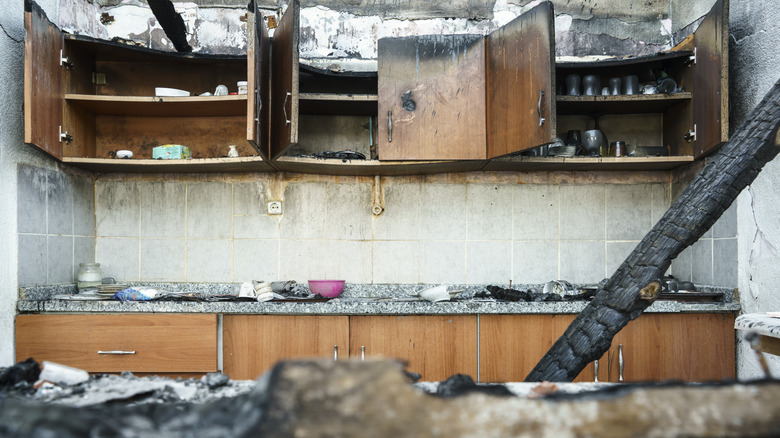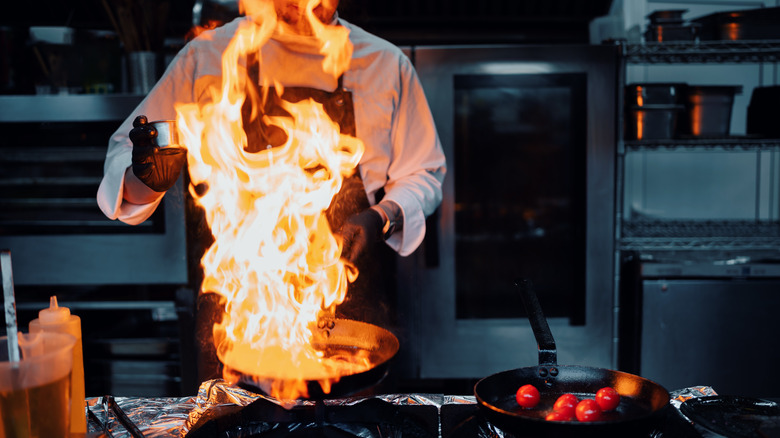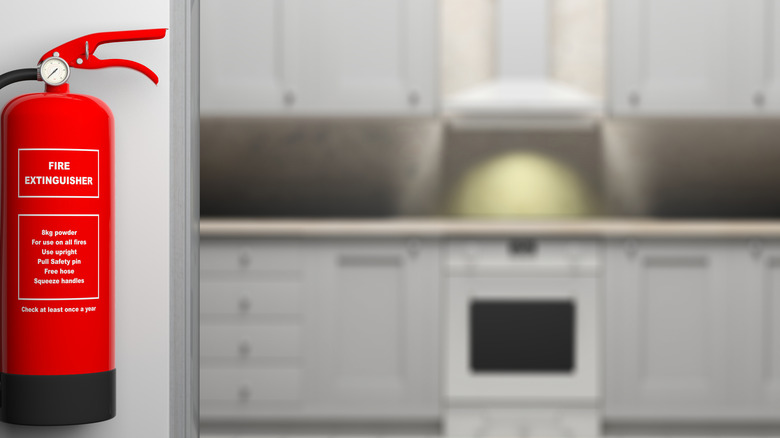Kitchen Ingredients That Could Pose A Hidden Fire Risk
Most house fires start in the kitchen. The reason for this seems obvious: A kitchen is where a major source of heat or flames (the stove) often gets left unattended, leading to the ignition and spread. But there's more to kitchens' notorious reputation for being a home's most fire-prone area. Kitchens also house a vast amount of flammable items, many of which you use in cooking. That's right; seemingly innocent ingredients like flour and sugar are actually hidden fire hazards in your house.
Unfortunately, the list of flammable kitchen ingredients goes on. All types of cooking oil can catch fire, albeit at varying flashpoints. This means that if the flame from a gas burner jumps onto the pan with oil, it may well cause a fire in the pan. Now, we've all seen professional chefs flambéing on purpose, but you may want to steer clear of such dangerous situations at home. It's the same story with items we use to spice our food, like garlic, cinnamon, and even orange. And if you're a fan of stocking snacks in your pantry, beware — chips, Doritos, and even popcorn are all prone to catching fire. Below, we'll explain why these common ingredients and foods present a hidden fire risk, walk you through strategies for mitigating the risk of kitchen fires, and explain how to fight flames in the worst-case scenario.
What makes these kitchen ingredients flammable
Flour is flammable because it contains starch, a complex carbohydrate laden with glucose. This glucose is the flammable element in flour. So much so that flour particles suspended in the air can easily cause an explosion when exposed to a fire source. If the flour dust cloud is particularly large, it can even combust on its own. Now, if you're rightly not too worried about producing large, explosive clouds of flour in your home, consider this — flour that gets onto a hot, dry pan with nothing else in it can easily ignite and leave you with a fire on the stovetop.
Sugar can catch fire thanks to the same mechanism that kindles flour. It also contains glucose and ignites quickly upon coming in contact with flames or due to overheating. Meanwhile, cinnamon ignites for a different reason (as a result of its eugenol and cinnamaldehyde content) but behaves much like flour, presenting the greatest risk when its particles are suspended in the air.
Cooking oils pose a kitchen fire risk because of their triglyceride composition, which is flammable. Cooking oils release vapors in response to heating up, and the vapors can ignite if they reach their flashpoint temperature. This flammability is a significant risk since we usually preheat oil before cooking. According to a 2018 study published by the Journal of Fire Sciences, cooking oil is the first ingredient to ignite in 52% of fires originating in the kitchen. Garlic torches for the same reason since it's packed with oils.
How to prevent and fight kitchen fires
Preventing kitchen fires requires a multi-pronged approach on your part. You should understand and mitigate known fire risks, like those posed by common kitchen ingredients you use. In simple terms, this means not letting these flammable items get close to a source of fire. Being mindful and paying attention to your cooking equipment while preparing food is equally paramount since many kitchen fires start when the cook is distracted. Distractions like fatigue or alcohol are notably dangerous because they can cause you to forget about what's happening on the stove and create the ideal conditions for flammable ingredients to catch fire.
Keeping a fire extinguisher handy can help you safely handle a grease fire in the oven or stove. However, note that you can't just use any old fire extinguisher to fight a cooking fire — especially one that involves grease. For example, a water-filled Class A extinguisher would only cause a grease fire to spread. Instead, equip your kitchen with a K-class extinguisher, which relies on potassium acetate, potassium carbonate, or potassium citrate to saponify the grease and starve the flames of oxygen. Kitchen fire extinguishers are readily available at online retailers. Learn what places in your home are best for storing a fire extinguisher.


